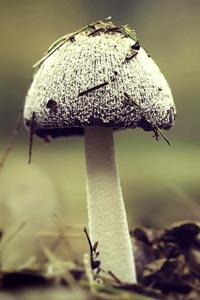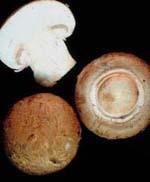
"Nature alone is antique, and the oldest art a mushroom." --Thomas Carlyle
The name mushroom is used to describe over 38,000 varieties of fungus. Part delicious, part deadly, part intoxicating, and marvellously mysterious, we love the mushroom.
For most of history the world was divided into the East who loved mushrooms and the West, who did not (probably due to fear of the dangers.) But as a consequence of the French introduction of the mushroom into their high cuisine, the mushroom found its hallowed place, and is now more popular than ever, with the "diamond" of all fungi, the truffle, being the most expensive food in the world.
But beyond being delicious, the mushroom is also one of the most fascinating biologies on earth. It is much more complex than we imagine from what we see (and eat,) or what is called the "fruit". The larger organism, the mycelium, exists beneath. It is a network of threadlike cells made out of tiny filaments called hyphae.
Mycelium typically grow in the soil beneath tress and other plants, where they may even create collectives with the tree roots, forming symbiotic relationships. Their characteristics are nothing short of amazing. Via epigenesis, their ability to adapt to changing environmental conditions, mushrooms are able to resist microbial attacks, extreme temperatures and conditions, and they can live for long times.
There is a wonderful, almost spiritual dance to their method of co-existing in the world.
The actual mycelium plant is usually spread over a relatively large area and so it usually goes unnoticed. In fact, the largest living organism on the planet is the Armillaria Ostoyae, growing over 3 plus square miles of land in the Blue Mountains of Oregon. What we see above ground is the bulb produced by these networks that emerges to disperse millions of spores and thereby reproduce. The mushroom itself has no other purpose than to be fruit and to enable propagation.
But surely the most fascinating aspect of the mushroom is the way it interacts with its environment, actively manipulating and influencing, whether it be the soil, trees, insects, and even the weather. According to UCLA researcher Marcus Roper, they cool the air around them by releasing water vapor, creating convection currents strong enough to lift the spores into the air and push them out and away from the mushroom.
Moreover, the variety of methods and the intelligence with which they use their environment is a marvel of evolution. For example, it is thought that the high protein content of mushrooms makes them attractive to animals, in spite of the fact that many animal species are highly allergic to them. Cats are known to eat mushrooms even though they have strong negative reactions. It's almost as though the fungus knows how to override the instincts of other species, superimposing its own will.
Some fungi will send out spores that attach to insects, absorbing into their systems and travelling to the brain, influencing and reprogramming their behavior. One particular species infects the brains of ants, causing them to return to their anthill, rise to the top and then erupt with the spores, sending them showering down over the other ants to continue the cycle. Other types will force ants to climb to a specific height, clamp themselves to a plant, and then wait till the spores explode out and float down over more insects below to repeat the cycle.
The obvious intelligence in these spores is simply remarkable. Some anthropologists have even speculated that it may have been the ingestion of psychoactive mushrooms that gave humanity its evolutionary bump from simple ape to the more complex being that could contemplate it's own meaning in the world, and believe in a god. The first art of cave painting may have begun as a result of the mushroom experience.
The spores of mushrooms are made of chitin, the hardest naturally-made substance on Earth. Scientists speculate that spores can travel in space, and may have been carried here on asteroids, etc, so in that sense they may be alien life.
Either way, we are firm believers that the mushroom is truly something special.
 Mushrooms are actually vital to our existence on this planet. Fungi recycle dead plants, transforming them into rich soil. If not for fungi, we would be buried in plant debris and life on the planet would quickly vanish. The hindus believe the mushroom to be holy, which may be partly related to the way they fortify the plants around them.
Mushrooms are actually vital to our existence on this planet. Fungi recycle dead plants, transforming them into rich soil. If not for fungi, we would be buried in plant debris and life on the planet would quickly vanish. The hindus believe the mushroom to be holy, which may be partly related to the way they fortify the plants around them.
The pine tree, for instance, will use mycelium as an extension of its own root system, forming intertwinings so the fungi’s efficiency at absorbing water and minerals helps improve the trees health and protects it during droughts.
They have a unique capacity for taking harmful elements in nature and processing them to be harmless and useful. Besides being exulted for their anti-microbial and bacterial powers, they are also used in remediation of toxic spills to absorb toxic materials and destroy harmful bacteria. Scientists at the Albert Einstein College of Medicine recently discovered that they can even use radioactivity as an energy source for making food and for growth. Remarkable!
Mushroom spores are rich in chitosan which promotes the healing of wounds. When bandages containing chitosan were used on patients' wounds, observers reported inhibition of microbial growth and faster re-epithelialization.
Scientists from Amala Cancer Research Centre have found significant anti-inflammatory and anti-tumor qualities in the mushroom extract. The agarikon variety is known to be anti-tubercular. History tells us that it is the oldest medicinal, and that Hippocrates used to prescribe it religiously for inflammation.
Research done at the Georgetown University Medical Center in Washington, DC. showed that "Long-chain sugar molecules in these tasty bites heal and energize pancreatic cells. The result: optimized insulin output and up to a 22% reduction in fatigue-triggering blood-sugar fluxes...To get the benefits, consume 1/2 cup of mushrooms (raw or cooked) per day." This is great news for diabetics.
From a health perspective, mushrooms are tiny pharmaceutical factories. They produce all kinds of critical nutrients that have been identified for their importance to human wellbeing.
There's a lot of nutritional power in the "fruit" called mushroom.
 >> As mentioned, they are made of dense protein, high levels of key minerals like potassium and copper, beta-glucans, and complex polysaccharides, which all contribute to healthy immune function.
>> As mentioned, they are made of dense protein, high levels of key minerals like potassium and copper, beta-glucans, and complex polysaccharides, which all contribute to healthy immune function.
>> A medium-sized mushroom contains more potassium than a banana, and is one of the richest sources of the antioxidants selenium and ergothioneine, which may be one of the reasons for its powerful anti-cancer and anti-inflammatory effects.
>> Mushrooms are one of the very few natural sources of vitamin D.
>> Mushrooms are an excellent source of a range of vitamin B's.
>> It is rated in the top ten healthiest of all foods.
Here are some mushroom prep tips:
Cooking breaks open the fungal cells that are protected by the hard chitin, more fully releasing the protoplasm or cell contents for our digestive systems to utilize. It is a good idea to cook mushrooms and avoid raw mushrooms for the most part.
Leave mushrooms in the sun for a couple of hours to significantly increase levels of vitamin D. Mushrooms love sun and absorb and store it. Another fabulous trait!
Turn the mushroom over and check the gills - the darker they are, the more flavor the mushroom will have.
Here's a few simple ways to enjoy mushrooms:
Leave mushrooms marinating in a nice vinagrette for two days before enjoying.
Crazy Good Flavoring Powder: dry mushroom slices, place on a baking sheet, place in a preheated 300º oven and bake until brown. After cooled, place in a blender or a food processor with a teaspoon of sea salt, ground black pepper, cayenne, paprika and 2 teaspoons of cornstarch (to prevent caking) and blend to a fine powder. Store in a glass container and use as a seasoning for other foods. This will impart amazing flavor to any dish!
RELATED POSTS:
4 G's for Anti-Aging: garlic, ginger, ginseng, gingko biloba
The Power of Pomegranate Keeps You Young
References:
Weil, A. 1993. Boost immunity with mushrooms. Natural Health, May-June.
Toussaint-Samat, Maguelonne. A History of Food. Chichester, West Sussex, U.K.: Wiley-Blackwell, 2009. Print.
Growing Gourmet and Medicinal Mushrooms” by Paul Stamets.
“Mushrooms: cultivation, Nutritional Value, Medicinal Effect, and Environmental Impact” Second edition by Shu-Ting Chang and Philip G. Miles. CRC Press.
Law, David, 1996. Fungi as a platform for new medicine. Mushroom World, December, 1996.
Stanislaus, C., 1996. Ling zhi- medicine of kings. New Editions Health World.
Steinman, D., 1995. Potent protectors. Natural Health, Nov-Dec.
The opinions expressed in this article are of the author. Content and other information presented on the site are not meant to be medical advice or any substitute for professional advice, counseling, diagnosis, or treatment. Never delay or disregard professional medical or mental health advice from your physician or other qualified health provider.





